+86 311 85258258
+86 311 85258258
Sand casting, the most widely used casting process, utilizes expendable sand molds to form complex metal parts that can be made of nearly any alloy. Because the sand mold must be destroyed in order to remove the part, called the casting, sand casting typically has a low production rate. The sand casting process involves the use of a furnace, metal, pattern, and sand mold. The metal is melted in the furnace and then ladled and poured into the cavity of the sand mold, which is formed by the pattern. The sand mold separates along a parting line and the solidified casting can be removed.
Sand casting is used to produce a wide variety of metal components with complex geometries. These parts can vary greatly in size and weight, ranging from a couple ounces to several tons. Some smaller sand cast parts include components as gears, pulleys, crankshafts, connecting rods, and propellers. Larger applications include housings for large equipment and heavy machine bases. Sand casting is also common in producing automobile components, such as engine blocks, engine manifolds, cylinder heads, and transmission cases.
The six steps of the sand casting process are; placing the mold in patern in sand, setting up the gating system, removing the mold pattern, pour molten metal into mold cavity, wait for the metal to cool, the final step is to break open the mold to remove the casting.
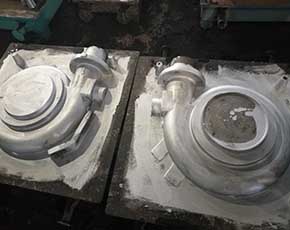
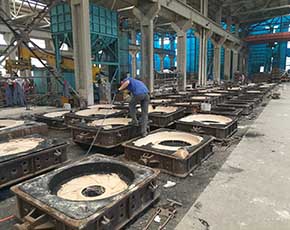
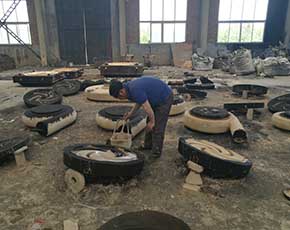
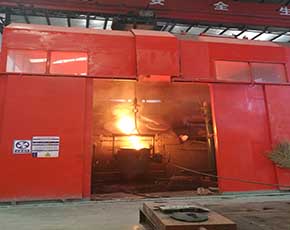
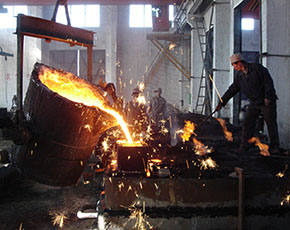
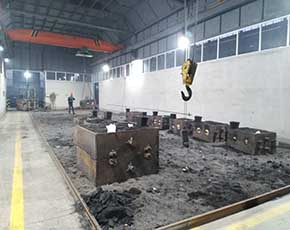
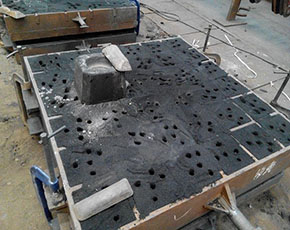
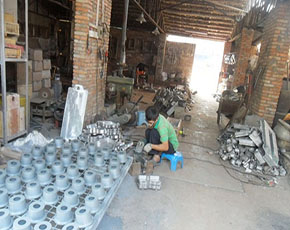
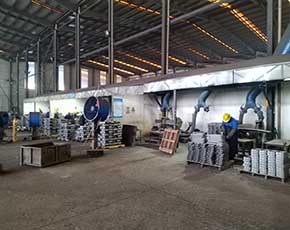
Molding sand is a material used for molding in casting. molding sand is generally made of foundry sand, sand binder and auxiliary additives and other molding materials mixed in a certain ratio, or natural silica sand containing clay. The casting scrap caused by poor quality of molding sand is about 30 to 50% of the total casting scrap. Usually the molding sand requirements are: ① has a high strength and thermal stability, to withstand a variety of external forces and high temperature. ② good fluidity, that is, the molding sand in the external force or its own gravity under the action of the ability to move between the sand particles. ③ A certain plasticity, that is, the ability of molding sand to deform under the action of external force, and to maintain the given shape when the external force is removed. ④Better permeability, i.e. the ability of molding sand pores to transmit gas. ⑤ high collapse, also known as sand, that is, after the casting solidification molding sand is easy to destroy, whether it is easy to remove the performance from the casting. molding sand according to the different binders used, can be divided into clay sand, water glass sand, cement sand, resin sand, etc.. The clay sand, water glass sand and resin sand are the most used.
The sand casting process has many advantages, especially in investment casting, another popular casting method (for more information, please read our article all about investment casting). This section will briefly explore why sand casting is so widely distributed in industry, and its shortcomings as a manufacturing method.
Sand casting can be used to make almost any size part from a trigger to an engine block - if the correct mold is made, there is no limit to the size of the part required
Very complex parts can be made with sand casting if the correct core/pouring system is used
The process is highly adaptable and can be implemented in mass production of parts
Almost all types of alloys can be cast, provided they can be melted and poured
Low equipment costs, as it usually involves only sand and reusable patterns
short lead times for making molds, making sand casting ideal for short-term production
Low setup costs for sand casting and cost effective modifications
Sand casting creates a high degree of porosity in the metal, resulting in low strength of the final part
Poor surface finish of the outgoing mold, which must be cleaned
Low dimensional accuracy of the casting due to poor surface finish and shrinkage of the metal after cooling
Sand casting is not defect-proof, so cleaning is mandatory and can be time-consuming
Sand castings with low tolerances must undergo some secondary processing
Therefore, although sand casting may be a cheaper alternative to investment casting and can provide more complex shapes, more work is required to obtain the same accuracy, finish and overall part quality.
It is difficult to keep track of how many different techniques use sand casting. Its versatility as a casting process makes it ideal for almost any complex part, and almost all modern technologies benefit from this manufacturing process. The following list of only a few products manufactured using the sand casting process shows how wide the range of possible applications can be.
Sand casting is used to manufacture the following products.
A wide range of pistons and valves Sand casting
Blowers/impellers Sand casting
Cams, bushings and bearings Sand casting
Electronic equipment Sand casting
Gas/oil tanks Sand casting
Most hardware Sand casting
Engine blocks Sand casting
Screws, nuts and gears Sand casting
Agricultural machinery Sand casting
Medical equipment Sand casting
and much more.
Sand casting, while nowhere near as precise as investment casting, is a low-cost, low-complexity manufacturing process that has repeatedly proven itself to be an integral part of modern manufacturing. If investment casting is too cumbersome, or if large parts are required, consider implementing sand casting into your production line.
For many years, Zen Young Foundry has been providing customized metal casting services for various industries and project types.
Mining Engineering Machinery Casting Parts
If you are looking for a solution that fits your custom metal Sand casting project, Zen Young can help you produce perfect metal parts through a reliable casting process.
We always welcome special material and difficult parts and would like to help our comstomers utmost.
Investment casting is one of the traditional casting methods. That is, the metal is heated to the temperature of the molten liquid, and then the material is poured into a mold designed with a suitable negative space and gated to effectively completely fill the molten metal. Once the metal has cooled and solidified, the metal part can be removed from the mold for finishing. Investment casting, also known as lost wax casting, is usually used to make jewelry and metal parts with complex shapes.
The material used to make molds for sand casting is sand, not ceramics. Due to the roughness of sand, sand casting is most commonly used for large castings, which usually require less detail precision and tolerances.
Die casting is a kind of metal casting process, which is characterized by forcing molten metal under high pressure into the forming cavity. The cavity is made using two hardened tool steel molds, which have been processed into a certain shape, and die casting works similarly to injection molds.
We will choose different casting methods for processing according to the product shape, material and your working conditions. Many years of processing experience can guarantee the quality of the casting parts.
We work with our customers to design patterns and molding methods for each custom casting. Original castings or ready-to-use castings can be provided. Secondary finishing operations, including powder coating, are additional options. Contact us with any questions about the casting process and also for more information on how our casting services can meet your project requirements.